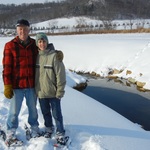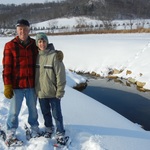
Success Story: John and Kim Annear
Shortly after joining the Richland Center police force 30 years ago, John Annear and his wife Kim started looking for a place in the country to raise their two young boys. They found 32 acres with fields, woods and a stream.

“We wanted to give our boys a sense of place in nature,” recalls John. Today, Paul (25 yrs. old) and Luke (27 yrs. old) come home to connect with mom and dad, of course, but also with the land. “They come back to hunt and fish, which is priceless to us,” beams John with an easy smile.
It’s clear, John and Kim feel blessed for what the land has given their family. However, decisions about what to do for the land itself weren’t always easy. “We bought with the idea to make the land better. But then we fell in love with the woods just the way it was,” John says. “We had real concern about creating change.”
Learning to welcome change
In 1993, according to their forestry plan, the Annears conducted their first timber harvest. For the first couple of years they didn’t know how to feel. It was a change from what they knew, but some of the changes were surprisingly pleasing.
“Bow hunting is a passion of mine. Seeing deer bed down in cover we created during the harvest made me appreciate change,” John says.
The harvest also created some gaps in the tree canopy where light flooded the ground and shrubs and young trees started to grow, creating wildlife food and cover. And just like that, the Annears welcomed change.
In 1997, the Annears bought another 70 acres on the other side of a stream bordering their property. The stream made the new purchase hard to reach, so they worked first with the Natural Resources Conservation Service (NRCS) through EQIP program to engineer and build a stream crossing.
A couple years later, through another NRCS program, they built a wetland scrape; a very shallow excavation for waterfowl and other wildlife. And after that, they conducted a second harvest that was profitable because of a smart harvest 14 years previous.
Next, they bought more land, bring their total acreage to 115, then did a stream improvement project that stabilized 700 feet of outside banks and improved fish habitat. And most recently, a they planted shrubs for wildlife habitat between the wetland scrape and the woods. “The deer don’t have to step outside of cover to get from the woods to the water,” smiles John, “They use it all the time.”
For the past few years John has been a Woodland Advocate and met with many woodland owners in his township. “Maybe we have done more projects than most, but we have the same anxieties and concerns about change, he reflects.” But there again is John’s easy smile, leaving little doubt that he appreciates the kind of change that turns rip-rapped stream banks into trout, wetland scrapes into ducks and young brush into deer…especially during bow season.
